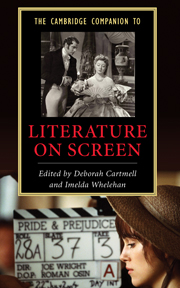Book contents
- Frontmatter
- Introduction - Literature on screen: a synoptic view
- Part One Theories of Literature on Screen
- Part Two History and Contexts
- Part Three Genre, Industry, Taste
- 8 Heritage and literature on screen: Heimat and heritage
- 9 “Don’t let’s ask for the moon!”: reading and viewing the woman’s film
- 10 Post-classical fantasy cinema: The Lord of the Rings
- 11 Adapting children's literature
- 12 Literature on the small screen: television adaptations
- Part Four Beyond the "Literary"
- Further reading
- Index
- Series List
9 - “Don’t let’s ask for the moon!”: reading and viewing the woman’s film
from Part Three - Genre, Industry, Taste
Published online by Cambridge University Press: 28 September 2007
- Frontmatter
- Introduction - Literature on screen: a synoptic view
- Part One Theories of Literature on Screen
- Part Two History and Contexts
- Part Three Genre, Industry, Taste
- 8 Heritage and literature on screen: Heimat and heritage
- 9 “Don’t let’s ask for the moon!”: reading and viewing the woman’s film
- 10 Post-classical fantasy cinema: The Lord of the Rings
- 11 Adapting children's literature
- 12 Literature on the small screen: television adaptations
- Part Four Beyond the "Literary"
- Further reading
- Index
- Series List
Summary
When examining popular fiction and its metamorphosis into film it is immediately clear that we are not just concerned with the relationship between an individual book and its cinematic interpretation, but with the history of genre fiction in the two media, and the place it is accorded in literary and film studies respectively. Popular romantic fiction is assigned the position of a “debased” genre and most commonly spoken about in terms of the mass market romance, which nonetheless claims its inspiration from some canonical classics, including Pamela, Pride and Prejudice, and Jane Eyre. In commercial terms it is a lucrative market, but critics regard its content as predictable, ideologically conservative, and undemanding of its reader. With very few nods to historical change, it has a formula which requires little adjustment to maintain its momentum; it has not matured into a literary form with active defenders (such as the fields of science fiction or the crime novel), and even now very few readers are keen to publicize their love of the genre. Romance assumes women are its readers and at the “bottom end” of the market - Mills & Boon or Harlequin - the publishers' market research has allowed them to consistently produce bestsellers, albeit those where the author's name is of little consequence. Critical attention was mainly negative until feminist critics reviewed their initial hostility to the manipulativeness of the form and turned their gaze on the woman as reader. From this perspective, and represented by pathfinding texts such as Tania Modleski's Loving with a Vengeance (1982) and Janice Radway's Reading the Romance (1987), there evolved some acute insights into the way women use popular cultural forms to negotiate their own life certainties and to endorse choices that can, without much interrogation, be shown to have little to do with the vicissitudes of relationships and romantic love.
- Type
- Chapter
- Information
- The Cambridge Companion to Literature on Screen , pp. 138 - 153Publisher: Cambridge University PressPrint publication year: 2007

